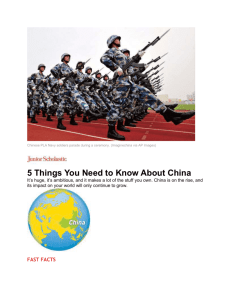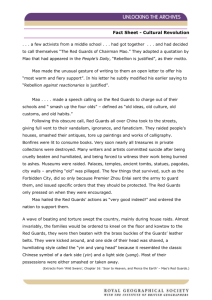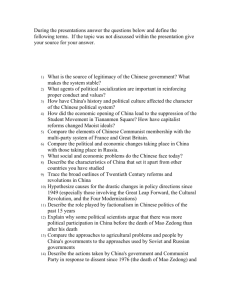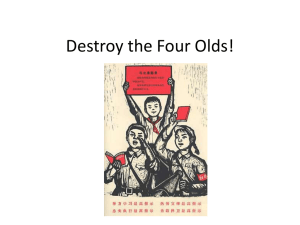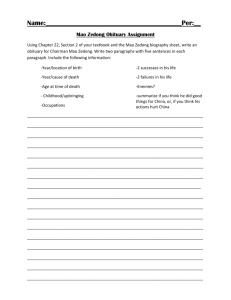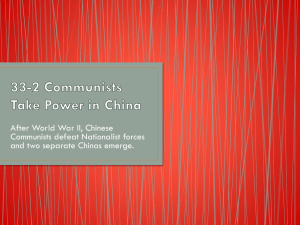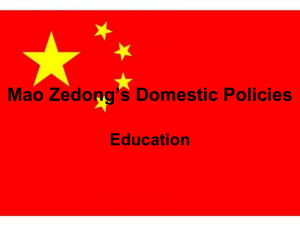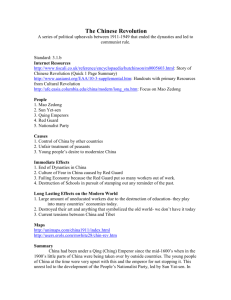Long March (1934-1935) This event saved the communists from
advertisement
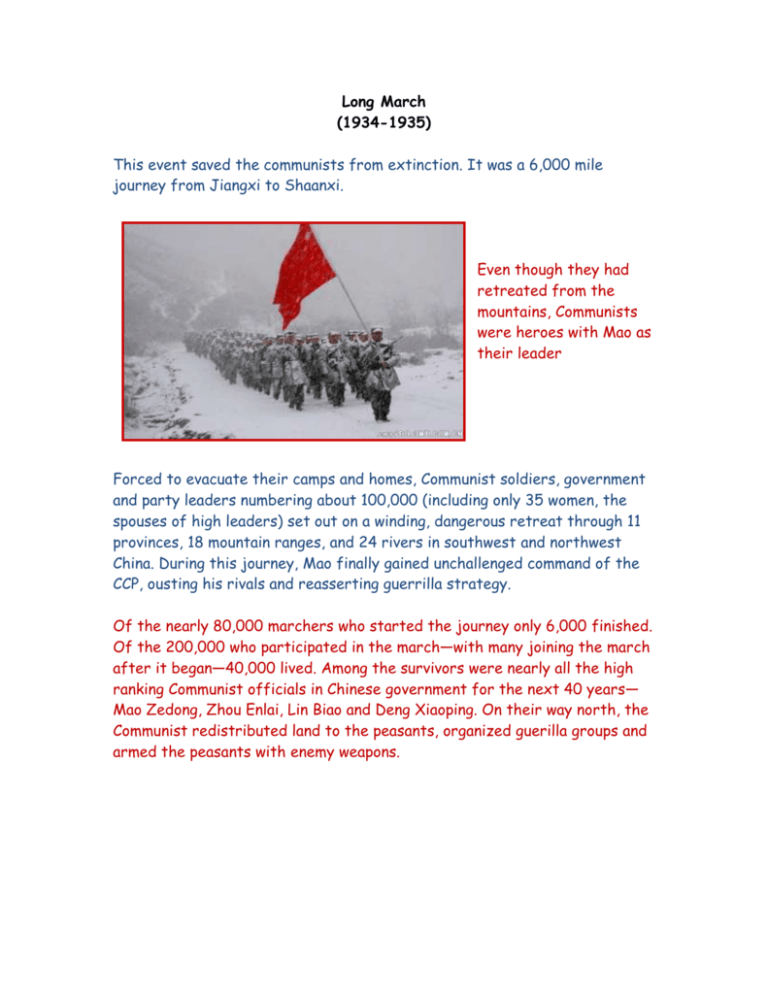
Long March (1934-1935) This event saved the communists from extinction. It was a 6,000 mile journey from Jiangxi to Shaanxi. Even though they had retreated from the mountains, Communists were heroes with Mao as their leader Forced to evacuate their camps and homes, Communist soldiers, government and party leaders numbering about 100,000 (including only 35 women, the spouses of high leaders) set out on a winding, dangerous retreat through 11 provinces, 18 mountain ranges, and 24 rivers in southwest and northwest China. During this journey, Mao finally gained unchallenged command of the CCP, ousting his rivals and reasserting guerrilla strategy. Of the nearly 80,000 marchers who started the journey only 6,000 finished. Of the 200,000 who participated in the march—with many joining the march after it began—40,000 lived. Among the survivors were nearly all the high ranking Communist officials in Chinese government for the next 40 years— Mao Zedong, Zhou Enlai, Lin Biao and Deng Xiaoping. On their way north, the Communist redistributed land to the peasants, organized guerilla groups and armed the peasants with enemy weapons. Great Leap Forward (1949-1959) This was Mao’s plan to develop agriculture and industry. During this time, the figures for steel, coal, chemicals, timber, and cement all showed huge rises though the beginning figures were very low. Grain and cotton production also showed major increases in production. Mao’s plan failed: 1. Quickly produced farm machinery produced in factories fell to pieces when used. 2. Many thousands of workers were injured after working long hours and falling asleep at their jobs. 3. Steel produced by the backyard furnaces was frequently too weak to be of any use and could not be used in construction – its original purpose. 4. Buildings constructed by this substandard steel did not last long. 5. Some parts of China were hit by floods. In other growing areas, drought was a major problem. It is estimated that 20 million people died of starvation or diseases related to starvation. Cultural Revolution (1966-1969) This was a period of great political and social turmoil within 20th Century. Mao was worried that some of the Communist Party leaders wanted to change his communist plans. Mao needed to keep Communist Party authority while overthrowing some of its leaders. Mao wanted to regain authority, so he used his followers to do so. Red Guards were formed. These were teenage volunteers summoned by Mao to defend Chinese socialism from 'evil forces'. Mao called for Red Guards to challenge Communist Party officials, business owners, and teachers. Mao wanted only one class system and education created a higher class. This was unacceptable. Schools were closed to free students to join the Red Guards. Officials, business, owners, and teachers were accused. Then they were imprisoned, beaten, and either worked to death or left to die in solitary prison. “One August afternoon in 1966, Youqin Wang watched in shock as her 10th-grade classmates began torturing five of their school administrators. On the playground of the elite Girls Middle School, attached to Beijing Teachers University, she saw these students, who had declared themselves among Mao Tse Tung’s Red Guards, splash black ink on the adults and hang large wooden boards scrawled with ‘counterrevolutionary’ around their necks. Ms. Wang, who was 13 at the time, slipped out of the crowd as soon as she could and returned to her dormitory. In the dining room that night, she overheard some Red Guards giggling about how they had poured boiling water over their victims. They had also beaten the teachers with nail-spiked clubs and forced them to eat dirt. That evening, the first vice principal, a 50-year-old woman who had worked at the school for 17 years, died after losing consciousness three hours into the torment. Zhongyun Bian became the first educator beaten to death by students in Beijing.” Tiananmen Square Massacre In April, protesters of all ages across China began leading demonstrations which criticized the Chinese government. Students were mostly involved in these protests across China. This was the site of several protests during this period, including a student hunger strike. The protests grew larger as word spread. Many people suspected that these mass protests would mark a new era in Chinese history. By May 20th, the Chinese government had difficulty forcing the protests to stop due to the thousands of protesters. One of the most enduring images from the Tiananmen Square massacre is a photograph of a lone man standing in front of a line of tanks as they attempt to enter the Square. The fate of “tank man,” sometimes called the “unknown rebel,” is unknown. When the troops entered this place, they opened fire on the protesters who were gathered there. Troops even fired at each other in the confusion, as protesters tried to find shelter and news agencies looked on in horror. Within hours, photo and video of the event had been sent to the outside world, and to this day, no one knows how many civilians died as the Chinese government has sealed that information like it never happened. Long March (1934-1935) Great Leap Forward (1949-1959) Cultural Revolution (1966-1969) Tiananmen Square Massacre (1989)

